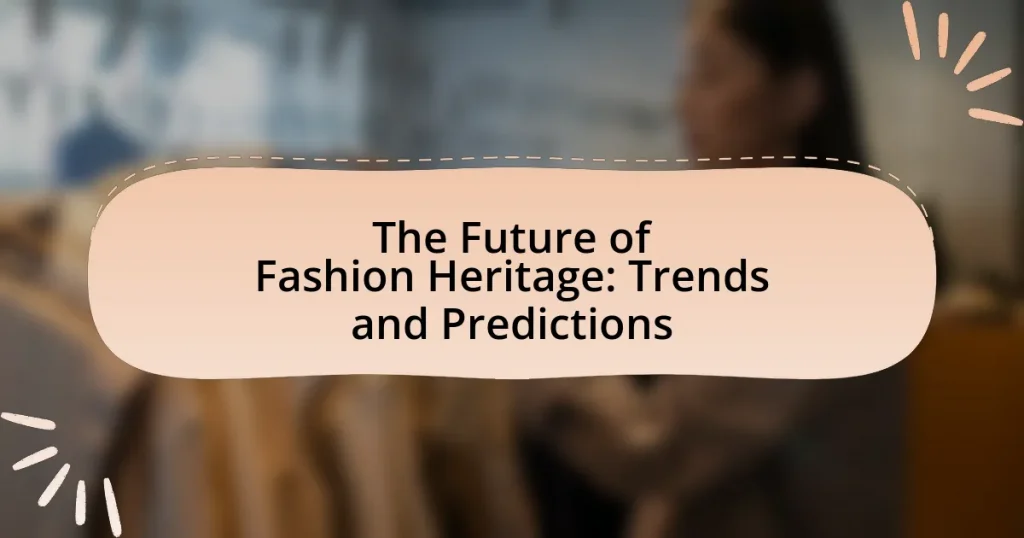The article examines the future of fashion heritage, highlighting trends such as sustainability, digital preservation, and inclusivity. It defines contemporary fashion heritage as the preservation and reinterpretation of historical elements that influence modern practices, emphasizing the importance of traditional craftsmanship and cultural narratives. The piece discusses historical influences on current fashion, the role of cultural narratives, and the significance of preserving fashion heritage for identity formation and sustainability. Additionally, it explores the impact of technology and innovation, emerging trends, and the challenges faced in preserving fashion heritage, while providing practical steps for individuals to support and honor this vital aspect of cultural identity.

What is the Future of Fashion Heritage?
The future of fashion heritage is characterized by a growing emphasis on sustainability, digital preservation, and inclusivity. As consumers increasingly demand environmentally responsible practices, fashion brands are integrating sustainable materials and ethical production methods, reflecting a shift towards preserving cultural heritage while minimizing environmental impact. Additionally, advancements in technology, such as virtual reality and blockchain, are enabling the digital archiving of fashion history, allowing for greater accessibility and engagement with diverse cultural narratives. This evolution is supported by research indicating that 66% of global consumers are willing to pay more for sustainable brands, highlighting the market’s shift towards valuing heritage that aligns with ethical standards.
How is fashion heritage defined in contemporary society?
Fashion heritage in contemporary society is defined as the preservation and reinterpretation of historical fashion elements that influence current trends and practices. This definition encompasses the ways in which traditional craftsmanship, iconic designs, and cultural narratives are integrated into modern fashion, reflecting a blend of nostalgia and innovation. For instance, brands like Gucci and Dior often reference vintage styles and techniques, showcasing how heritage can inform contemporary aesthetics while appealing to consumer desires for authenticity and sustainability. This approach is supported by the growing trend of upcycling and the revival of artisanal skills, which emphasize the importance of heritage in creating a sustainable future for the fashion industry.
What historical influences shape current fashion heritage?
Historical influences that shape current fashion heritage include cultural movements, technological advancements, and socio-political events. For instance, the Industrial Revolution in the 18th and 19th centuries introduced mass production techniques, which transformed clothing accessibility and styles. Additionally, the 1920s flapper movement reflected changing gender roles and social freedoms, influencing modern women’s fashion. The punk movement of the 1970s challenged traditional aesthetics and norms, leaving a lasting impact on contemporary streetwear. These historical contexts provide a foundation for understanding how past trends and societal shifts continue to inform and inspire current fashion practices.
How do cultural narratives impact fashion heritage?
Cultural narratives significantly impact fashion heritage by shaping the values, aesthetics, and practices associated with clothing and style. These narratives, which encompass historical events, social movements, and collective identities, influence how fashion is perceived and created within different cultures. For instance, the rise of sustainable fashion is deeply rooted in narratives surrounding environmental awareness and social responsibility, reflecting a shift in consumer values. Additionally, fashion designers often draw inspiration from cultural stories, leading to the revival of traditional techniques and materials, which preserves and honors heritage. This interplay between cultural narratives and fashion heritage is evident in the global popularity of indigenous designs, which highlight the importance of cultural identity and storytelling in contemporary fashion.
Why is the preservation of fashion heritage important?
The preservation of fashion heritage is important because it safeguards cultural identity and historical context. Fashion heritage reflects the social, economic, and artistic values of different eras, providing insight into societal changes and influences. For instance, the preservation of traditional garments, such as kimono in Japan or the sari in India, helps maintain cultural practices and fosters a sense of belonging. Additionally, studies show that understanding fashion history can inspire contemporary designers, leading to innovation while respecting tradition. This connection between past and present is crucial for sustaining the fashion industry’s evolution and relevance.
What role does fashion heritage play in identity formation?
Fashion heritage plays a crucial role in identity formation by providing individuals with a sense of belonging and cultural continuity. This connection to historical styles and traditional craftsmanship allows people to express their personal and collective identities through clothing choices. For instance, studies show that individuals often draw on their cultural backgrounds and historical fashion trends to create a unique personal style that reflects their heritage, thereby reinforcing their identity. Additionally, fashion heritage influences social dynamics, as shared styles can foster community ties and cultural , further solidifying one’s identity within a broader societal context.
How does fashion heritage contribute to sustainability?
Fashion heritage contributes to sustainability by promoting the use of traditional techniques and materials that minimize waste and environmental impact. By valuing craftsmanship and longevity, fashion heritage encourages consumers to invest in quality pieces rather than fast fashion, which often leads to excessive waste. Historical practices, such as hand-weaving and natural dyeing, not only reduce reliance on synthetic materials but also support local economies and preserve cultural identities. For instance, the revival of artisanal methods in various regions has been shown to decrease carbon footprints and foster sustainable practices within communities.

What are the emerging trends in fashion heritage?
Emerging trends in fashion heritage include a focus on sustainability, digital preservation, and the revival of traditional craftsmanship. Sustainability is increasingly prioritized as brands seek to reduce waste and promote eco-friendly practices, with 66% of consumers willing to pay more for sustainable products, according to a 2021 McKinsey report. Digital preservation involves using technology to archive and share fashion history, enabling broader access and engagement, exemplified by virtual exhibitions and online collections from institutions like the Museum of Fashion. Additionally, the revival of traditional craftsmanship is gaining traction, as consumers value artisanal skills and unique, handmade items, leading to a resurgence in local production and heritage techniques.
How are technology and innovation influencing fashion heritage?
Technology and innovation are reshaping fashion heritage by enabling the preservation, accessibility, and reinterpretation of traditional designs and techniques. Digital tools such as 3D printing and virtual reality allow designers to recreate historical garments with precision, while online platforms facilitate global access to fashion archives, making heritage more inclusive. For instance, the use of augmented reality in fashion shows enhances the viewer’s experience by blending historical context with modern aesthetics, as seen in brands like Balenciaga that incorporate digital elements into their presentations. Additionally, innovations in sustainable materials and production methods are prompting a revival of traditional craftsmanship, ensuring that heritage techniques remain relevant in contemporary fashion.
What digital tools are being used to document fashion heritage?
Digital tools used to document fashion heritage include 3D scanning, digital archiving platforms, and augmented reality applications. 3D scanning captures the intricate details of garments and accessories, allowing for accurate digital representations that can be preserved and shared. Digital archiving platforms, such as Fashion Cloud and Archive.org, enable institutions and individuals to store and organize fashion collections, making them accessible for research and education. Augmented reality applications enhance the experience of fashion heritage by allowing users to interact with historical garments in a virtual space, providing context and engagement. These tools collectively contribute to the preservation and dissemination of fashion heritage, ensuring that it remains accessible for future generations.
How does social media affect the perception of fashion heritage?
Social media significantly influences the perception of fashion heritage by democratizing access to historical fashion narratives and enabling real-time engagement with diverse audiences. Platforms like Instagram and TikTok allow users to share and reinterpret traditional fashion, leading to a broader appreciation and understanding of cultural significance. For instance, hashtags such as #VintageFashion and #FashionHistory have garnered millions of posts, showcasing how users celebrate and revive past styles, thereby reinforcing their relevance in contemporary culture. This shift not only elevates awareness of fashion heritage but also encourages discussions around authenticity and cultural appropriation, as seen in debates surrounding the use of traditional garments in modern fashion contexts.
What role do designers play in shaping the future of fashion heritage?
Designers play a crucial role in shaping the future of fashion heritage by innovating and reinterpreting traditional styles while integrating sustainable practices. They influence cultural narratives through their collections, often drawing inspiration from historical garments and techniques, which helps preserve and evolve fashion heritage. For instance, designers like Stella McCartney emphasize eco-friendly materials and ethical production methods, reflecting a shift towards sustainability that is becoming integral to fashion’s future. This approach not only honors past craftsmanship but also addresses contemporary environmental concerns, ensuring that fashion heritage remains relevant and respected in a modern context.
How are contemporary designers incorporating traditional elements?
Contemporary designers are incorporating traditional elements by blending historical techniques and motifs with modern aesthetics. This integration often involves the use of traditional fabrics, patterns, and craftsmanship, which are reinterpreted to create innovative designs that resonate with contemporary audiences. For instance, designers like Gucci and Valentino have utilized traditional embroidery and textile techniques from various cultures, showcasing them in their latest collections. This approach not only preserves cultural heritage but also appeals to consumers’ growing interest in authenticity and sustainability in fashion.
What are the implications of fast fashion on heritage preservation?
Fast fashion significantly undermines heritage preservation by promoting a culture of disposability and rapid consumption, which leads to the erosion of traditional craftsmanship and cultural identity. The production processes associated with fast fashion often prioritize speed and cost over quality, resulting in the neglect of artisanal techniques that are integral to cultural heritage. For instance, UNESCO recognizes the importance of traditional textile practices, which are threatened by the mass production of inexpensive garments that do not reflect local histories or craftsmanship. Additionally, the environmental impact of fast fashion, including waste and pollution, further jeopardizes the preservation of heritage sites and communities that rely on sustainable practices.

What predictions can be made about the future of fashion heritage?
The future of fashion heritage is predicted to increasingly emphasize sustainability and inclusivity. As consumers become more environmentally conscious, brands are likely to adopt practices that honor traditional craftsmanship while minimizing ecological impact. For instance, the rise of circular fashion, which promotes recycling and upcycling, reflects a shift towards valuing heritage techniques that can be adapted for modern use. Additionally, the integration of technology, such as digital archiving and virtual fashion shows, will enhance accessibility to fashion heritage, allowing a broader audience to engage with historical styles. This trend is supported by data indicating that 66% of global consumers are willing to pay more for sustainable brands, highlighting a significant market shift towards heritage that aligns with ethical practices.
How might consumer behavior evolve regarding fashion heritage?
Consumer behavior regarding fashion heritage is likely to evolve towards increased appreciation for sustainability and authenticity. As consumers become more environmentally conscious, they will prioritize brands that emphasize heritage craftsmanship and sustainable practices, reflecting a shift from fast fashion to timeless, quality pieces. According to a 2021 McKinsey report, 67% of consumers consider the use of sustainable materials important when making fashion purchases, indicating a growing trend towards valuing heritage brands that align with these principles. This evolution will also be driven by a desire for unique, culturally rich products that tell a story, as evidenced by the rise of vintage and second-hand shopping, which has increased by 32% in recent years.
What trends indicate a shift towards sustainable fashion practices?
Trends indicating a shift towards sustainable fashion practices include the rise of eco-friendly materials, increased consumer demand for transparency, and the growth of circular fashion initiatives. Eco-friendly materials, such as organic cotton and recycled polyester, are being adopted by brands to reduce environmental impact. Consumer demand for transparency is evidenced by a 2021 survey showing that 67% of consumers consider sustainability when making a purchase. Additionally, circular fashion initiatives, which promote recycling and upcycling, are gaining traction, with companies like Patagonia leading the way by encouraging customers to repair and recycle their products. These trends collectively reflect a significant movement towards sustainability in the fashion industry.
How will global events influence fashion heritage in the coming years?
Global events will significantly influence fashion heritage in the coming years by driving shifts in consumer behavior, sustainability practices, and cultural representation. For instance, the COVID-19 pandemic accelerated the adoption of digital fashion and e-commerce, reshaping how heritage brands engage with consumers. Additionally, social movements advocating for diversity and inclusion are prompting fashion houses to reevaluate their historical narratives and incorporate broader cultural perspectives. The rise of climate change awareness is also pushing the industry towards sustainable practices, which will redefine traditional fashion heritage by prioritizing eco-friendly materials and ethical production methods. These trends indicate that global events are not only reshaping current fashion practices but also altering the foundational aspects of fashion heritage for future generations.
What challenges lie ahead for fashion heritage preservation?
Fashion heritage preservation faces significant challenges, including the rapid pace of technological change, which can outdate traditional preservation methods. The rise of digital fashion and virtual reality creates a need for new strategies to document and conserve physical garments, as evidenced by the increasing use of 3D scanning and digital archiving in museums. Additionally, financial constraints limit the resources available for preservation efforts, with many institutions struggling to secure funding for conservation projects. The global nature of fashion also complicates preservation, as cultural appropriation and differing standards of care across regions can lead to inconsistencies in how heritage is maintained. These factors collectively threaten the integrity and continuity of fashion heritage.
How can the fashion industry address issues of cultural appropriation?
The fashion industry can address issues of cultural appropriation by prioritizing collaboration with cultural communities and ensuring respectful representation. Engaging in partnerships with designers and artisans from the cultures being represented allows for authentic storytelling and acknowledgment of cultural significance. For instance, brands like Gucci and Dior have collaborated with Indigenous artists to create collections that honor their heritage, rather than exploit it. This approach not only fosters inclusivity but also educates consumers about the cultural contexts behind the designs, reducing the likelihood of appropriation. Additionally, implementing guidelines and training on cultural sensitivity for designers and marketers can further mitigate appropriation risks, as seen in initiatives by organizations like the Council of Fashion Designers of America (CFDA).
What strategies can be implemented to combat the loss of traditional craftsmanship?
To combat the loss of traditional craftsmanship, strategies such as education, community engagement, and government support can be implemented. Education programs that focus on teaching traditional skills in schools and workshops can help preserve these crafts for future generations. Community engagement initiatives, such as local craft fairs and exhibitions, can raise awareness and appreciation for traditional craftsmanship, encouraging more people to participate. Additionally, government support through grants and subsidies for artisans can provide the necessary resources to sustain these practices. For instance, the National Endowment for the Arts in the United States has funded programs aimed at preserving traditional crafts, demonstrating the effectiveness of such support in maintaining cultural heritage.
What practical steps can individuals take to support fashion heritage?
Individuals can support fashion heritage by actively engaging in sustainable practices, such as purchasing from local artisans and brands that prioritize traditional craftsmanship. Supporting local artisans helps preserve unique techniques and cultural narratives associated with fashion heritage. Additionally, individuals can participate in educational workshops or events that focus on the history and significance of traditional garments, which fosters appreciation and awareness. According to a report by the United Nations Educational, Scientific and Cultural Organization (UNESCO), promoting traditional craftsmanship can enhance cultural identity and economic sustainability in communities. By choosing to repair and upcycle clothing instead of discarding it, individuals also contribute to the longevity of fashion heritage, reducing waste and honoring the craftsmanship behind garments.
How can consumers make informed choices that honor fashion heritage?
Consumers can make informed choices that honor fashion heritage by researching the history and cultural significance of fashion brands and their products. Understanding the origins of materials, craftsmanship techniques, and the stories behind traditional garments allows consumers to appreciate the value of heritage in fashion. For instance, brands that utilize artisanal methods or sustainable practices rooted in cultural traditions often reflect a commitment to preserving fashion heritage. Additionally, consumers can support local artisans and brands that prioritize ethical production, thereby contributing to the sustainability of fashion heritage. Studies show that consumers increasingly prefer brands with transparent supply chains, indicating a shift towards valuing heritage and authenticity in fashion choices.
What resources are available for learning about fashion heritage?
Books, online courses, and museums are key resources for learning about fashion heritage. Notable books include “Fashion History: A Global View” by Bonnie English, which provides a comprehensive overview of fashion’s evolution across cultures. Online platforms like Coursera and FutureLearn offer courses on fashion history and cultural significance, often featuring contributions from industry experts. Additionally, museums such as the Costume Institute at the Metropolitan Museum of Art and the Fashion Museum in Bath, England, house extensive collections that illustrate the historical context and development of fashion. These resources collectively provide a robust foundation for understanding fashion heritage.




